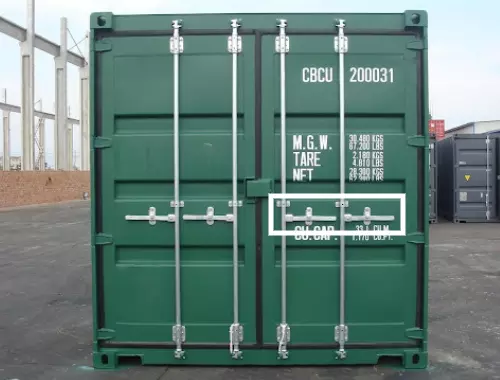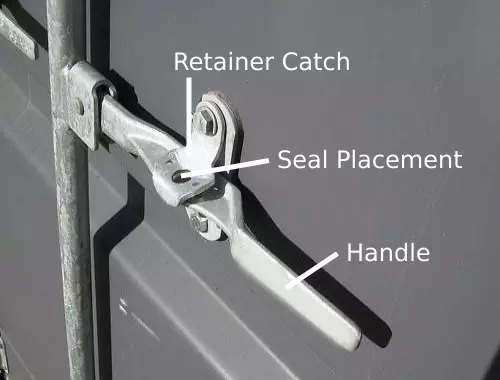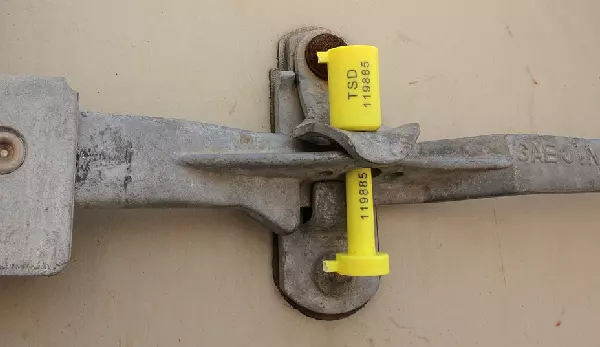Correctly sealing a shipping container is an essential part of the shipping process. The container seal is the most important safety device of a container and the only thing that keeps the cargo inside safe and secure.
This guide features an easy-to-follow process of properly sealing shipping containers. We will also be explaining what type of container seals are available and also answer important questions on container seal management.
How to Seal a Shipping Container
As sealing a shipping container is an extremely important task of the overall shipping process, we have broken it down into simple and easy-to-follow steps that you can find below.
1. Receive the Seal from the Shipping Line
All container seals are issued and provided by the shipping line that the booking was placed with. Even if you’re working with a freight forwarder, the container and container seal will be released by the shipping line, when picking up the empty container.
Therefore, the depot operators will release the container with a corresponding seal to the appointed trucker before they are delivered to the loading site. It’s good practice to ask your trucker to check if the seal pin and base have matching numbers upon container pick.
Container seals are commonly passed to truck divers, together with the Equipment Interchange Receipt (EIR) or the Container Release Form, when the shipping container is released. Take note that some carriers may charge a container seal fee.
2. Close the Container Doors
When the truck arrives at the shipper’s premises for loading, the container and seal are handed over to the shipper. The container is inspected before it’s loaded with cargo.
After all of the cargo is loaded, the container doors are closed. The left container door is closed first, followed by the right door. Have both door handles face outward, before pushing the door against the container and turning the handles in place.
Depending on the container, one handle may twist to the left, the other to the right. However, most containers are built in a way that both handles are closed by twisting away from the container.
Now, do the same for the right door. It’s important to note that before locking the container with a seal, you’ll need to ensure that the retainer catch is lowered and aligned with the handle. Proceed to the next step for a clearer picture
3. Place the Seal on the Container
To ensure that the container is ISO 17712 compliant, shipping lines will issue a high security seal upon releasing the container to the trucker. Before securing the seal, you’ll need to place the seal into the right position first.


As you can see in the first image, you should place the container seal either on the left or right handle of the right container door. This is because the right door is opened first.
The container seal is placed into the bolt between the handle and the retainer catch, which you can see in the right image. Ensure that you remove the pin and the base of the seal first.
Shipping containers require at least one high security seal. You may also want to place an additional container seal on the other handle or on the bottom cam. This seal position is called SecuraCam and offers additional safety.
4. Secure the Container Seal
Now it’s time to secure the seal. You can do this by pressing the pin and the base of the seal against each other. You should hear a clicking sound. That means that the seal is locked and secured.

Take note of the seal number on the seal and base to ensure that they are identical. You’ll also need to keep them as reference, as they need to be indicated on some of the shipping documents
Why Are Containers Sealed?
It’s important to seal shipping containers, as it’s the only locking device available. According to the relevant ISO guidelines, containers need to be sealed with at least one high security seal.
A container that is not properly sealed could be exposed to cargo theft, pilferage or other illegal activities. Moreover, shipping lines may not accept containers that are not sealed or incorrectly sealed, as it may lead to insurance disputes.
Therefore, sealing a container with an appropriate seal and the right process is in the interest of the shipper, shipping line and the consigner, as cargo theft may happen at the origin, destination or even during transit.
Types of Container Seals
According to ISO 17712 guidelines, there are various seals that may be used for locking a container. There are three different seal grades, depending on the security they offer:
- “I” stands for “Indicative”
- “S” stands for “Security”
- “H” stands for “High Security”
It’s always best to opt for high security seals, especially when shipping overseas. That is also one reason why carriers mainly supply bolt seals. The three seals that quality under the “H” rating for high security are bolt seals, bar seals and wire seals.
There are also various other types of seals that may be used for containers. Each has their own application and benefits. Let’s take a closer look:
- Bolt Seals – Issued by shipping lines as a standard for all sea shipment. These bolt seals contain a pin and a base and offer maximum security.
- Bar Seals – These seals are installed in the locking rods of each container door and also offer a high level of security. However, they are not convenient to transport.
- Wire Seals – A metal strip or wire that is tied around the locking rod, retainer catch, handle and cam of the container.
- Meter Seals – Meter seals have a metal wiring that is connected to a transparent body made of polycarbonate.
- Plastic Seals – A cost effective seal that is made of plastic. Once broken it cannot be reattached. Also the most fragile seal.
- Cable Seals – Made of metal and plastic and works similar to wire seals.
- Electronic Seals – Contain electronic information. It can send data like container position, shock readings and other types of information.
Who Issues Container Seals?
Seal issuance is done by the shipping line, together with the container release to the appointed trucker. Issuing seals allows carriers to ensure proper monitoring and assurance of the latest ISO compliance.
However, there is a difference if a shipper uses its own containers. Shipper Owned Containers (SOC) require shipper’s to use their own seal. In this case, the seal number has to be advised to the carrier.
Why Do Container Seals Come In Different Colors?
It can be observed that shipping line seals come in different colors. There is no significant meaning behind the color of a seal, other than for brand association purposes.
The different seal colors are not representative of a container number, type of load, or any other possible reason.
How Are Container Seals Documented?
The container seal number is an important data element that is used to identify if a seal has been broken and replaced. Therefore, the seal number is also recorded in various shipping documents, so that the consignee can ensure that the containers were not opened at any time before, during or after transit.
- Packing List – the seal number forms part of documentation of the items shipped. The packing list typically contains the container and seal number.
- Customs Declaration – When clearing cargo through customs, the container number, as well as the seal number need to be submitted.
- Bill of Lading / Sea Waybill – Indicating the seal number on the bill of lading is also required.
- Equipment Interchange Receipt – when a container is moved through an equipment interchange receipt (EIR), the container and seal number are an important reference.
What Happens When A Container Seal Is Broken or Missing?
Before a container is unloaded, the seal and its corresponding number must first be inspected against the shipping documents for any mismatch.
A broken seal may signify that the container may have been tampered with. In case this happens, the consignee must notify the carrier and insurance company to conduct a joint cargo survey.
If the surveyor has established that their cargo has been tampered with, a formal claim may be raised with the insurance company and a police report may be lodged.
What Happens to a Seal If the Container is Inspected By Customs?
One of the core functions of customs authorities is to assess if the cargo in question can be imported. During this assessment process, they may need to physically check the contents inside the container.
In order to do this, the customs authorities may need to break the container seal. After the assessment and physical checking is complete, they will use a special customs seal to secure the container.
In the event this happens, the new seal number from the customs department is advised to the consignee or its nominated agent.
How are Container Seals Removed from Shipping Containers?
Bolt cutters are used to cut high security seals on containers. To do this, the bolt cutter should be placed against the pin. The pin is then snapped by squeezing both handles of the bolt cutter.
The seal is now broken and the container doors can be opened. The broken seal may now be discarded.
Seal Management Policies of Carriers
Each carrier has their own seal management policy, in order to comply with ISO 17712 standards. Below, you’ll find the seal management policies of some of the largest shipping lines.
| Shipping Line | Seal Management Policy |
| Maersk | Seal Policy |
| CMA-CGM | Seal Policy |
| Evergreen | Seal Policy |
| Cosco | Seal Policy |
| MSC | Seal Policy |
| Hamburg Sud | Seal Policy |
| Hapag Lloyd | Seal Policy |
| ONE | Seal Policy |
| OOCL | Seal Policy |
| HMM | Seal Policy |

Get Free Course Access
If you enjoyed the article, don’t miss out on our free supply chain courses that help you stay ahead in your industry.

Gerrit Poel
Co-Founder & Writer
at freightcourse
About the Author
Gerrit is a certified international supply chain management professional with 16 years of industry experience, having worked for one of the largest global freight forwarders.
As the co-founder of freightcourse, he’s committed to his passion for serving as a source of education and information on various supply chain topics.
Follow us